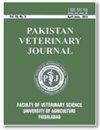埃及Dakahlia省肉鸡生产链中沙门氏菌污染的追踪
IF 3.8
3区 农林科学
Q1 VETERINARY SCIENCES
引用次数: 3
摘要
接收:修订:接受:在线发布:2018年11月26日2019年1月4日2019年01月07日2019年03月16日关于生产链的可用数据,特别是埃及家禽群的可用数据尚未完全阐明。该研究旨在深入了解沙门氏菌在肉鸡综合生产链的三个不同阶段的交叉污染。在440个采集的样本中,152个(34.5%)对沙门氏菌呈阳性。对应于从肉鸡综合供应链中的肉鸡养殖场(n=90,40.9%)、屠宰场接触面(n=12,24%)和鸡胴体(n=50,29.4%)采集的样本。沙门氏菌的分离和鉴定遵循标准程序。使用特异性寡核苷酸引物序列提取并确认基因组细菌DNA。沙门氏菌菌株分为11个血清型。发现9种不同的血清型污染肉鸡舍和鸡群,其中最常见的血清型为肠炎沙门氏菌(38.8%)、肯塔基沙门氏菌和鼠伤寒沙门氏菌。活肉鸡群中沙门氏菌污染的总频率为40.9%,阴沟拭子、垃圾、饲料、水、,农场墙壁和工人的手拭子。通过DNA测序鉴定了四个分离株(每个鼠伤寒沙门氏菌和肠炎沙门氏菌两个分离株)的PCR产物,以确定这些分离株中的潜在遗传关系。本研究的结果表明,不同的沙门氏菌血清型可以在生产链上持续存在,污染可能与最终产品的污染有关,对消费者的健康有潜在危害。©2019 PVJ。保留所有权利本文章由计算机程序翻译,如有差异,请以英文原文为准。
Tracing of Salmonella Contaminations Throughout an Integrated Broiler Production Chain in Dakahlia Governorate, Egypt
Received: Revised: Accepted: Published online: November 26, 2018 January 04, 2019 January 07, 2019 March 16, 2019 The data available regarding the production chain particularly in poultry flocks in Egypt are yet to be fully elucidated. The study aimed at providing an insight into the cross-contamination with Salmonella spp. at three different stages of an integrated broiler production chain. From 440 collected samples, 152 (34.5%) were positive for Salmonella spp. corresponded to samples collected from broiler farms (n=90, 40.9%), slaughter houses contact surfaces (n=12, 24%) and chicken carcass (n=50, 29.4%) in an integrated broiler supply chain. Isolation and identification of salmonella spp. were followed the standard procedures. Genomic bacterial DNA was extracted and confirmed using specific oligonucleotide primers sequences. Salmonella strains were classified into 11 serotypes. Nine different serotypes were found to contaminate thebroiler houses and flocks with the most prevalent serotypes S. Enteritidis (38.8%), S. Kentucky (23.3%) and S. Typhimurium (11.11%). The overall frequency of Salmonella contamination in the live broiler flocks was 40.9% with prevalence of 37.9, 60, 40, 53.3, 60 and 20% from cloacae swabs, litter, feed, water, farms walls and in the hand swabs from workers, respectively. The PCR products of four isolates, (two isolates per S. Typhimurium and S. Enteritidis) were identified by DNA sequencing to determine the potential genetic relationships in these isolates. The findings of the present study suggested that different Salmonella serotypes can persist along the production chain and that contamination could be linked to the contamination of the final product with a potential health hazard to consumers. ©2019 PVJ. All rights reserved
求助全文
通过发布文献求助,成功后即可免费获取论文全文。
去求助
来源期刊

Pakistan Veterinary Journal
兽医-兽医学
CiteScore
4.20
自引率
13.00%
发文量
0
审稿时长
4-8 weeks
期刊介绍:
The Pakistan Veterinary Journal (Pak Vet J), a quarterly publication, is being published regularly since 1981 by the Faculty of Veterinary Science, University of Agriculture, Faisalabad, Pakistan. It publishes original research manuscripts and review articles on health and diseases of animals including its various aspects like pathology, microbiology, pharmacology, parasitology and its treatment. The “Pak Vet J” (www.pvj.com.pk) is included in Science Citation Index Expended and has got 1.217 impact factor in JCR 2017. Among Veterinary Science Journals of the world (136), “Pak Vet J” has been i) ranked at 75th position and ii) placed Q2 in Quartile in Category. The journal is read, abstracted and indexed internationally.
 求助内容:
求助内容: 应助结果提醒方式:
应助结果提醒方式:


